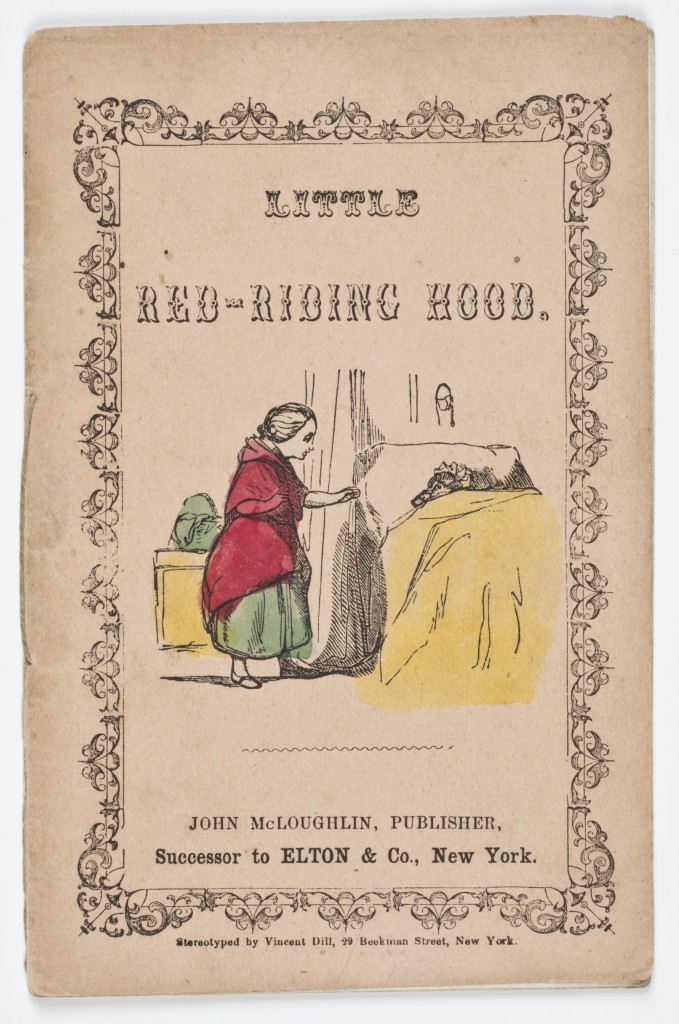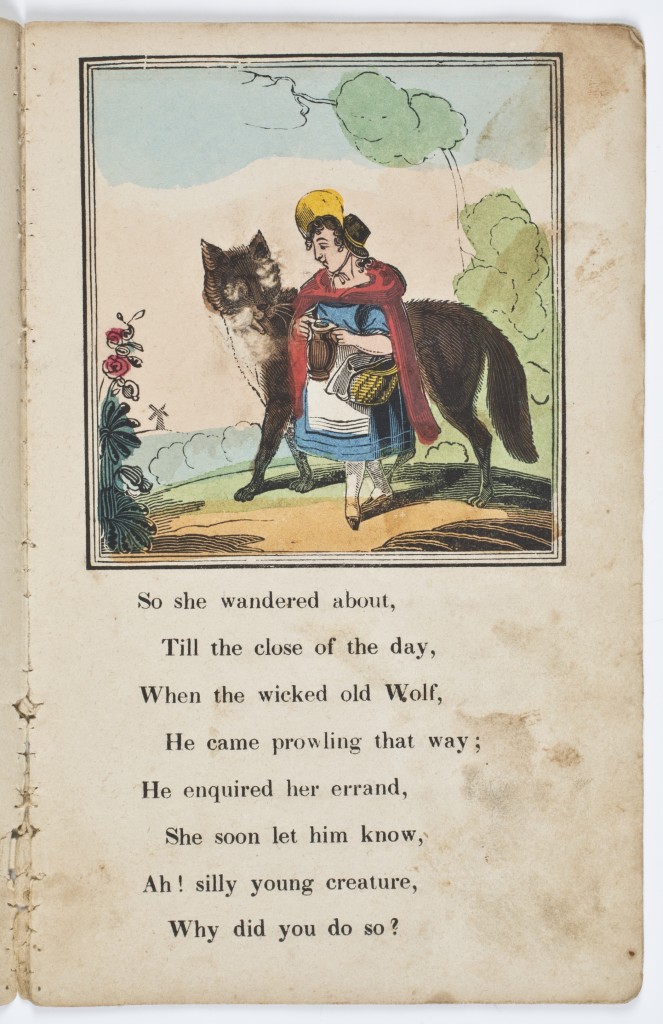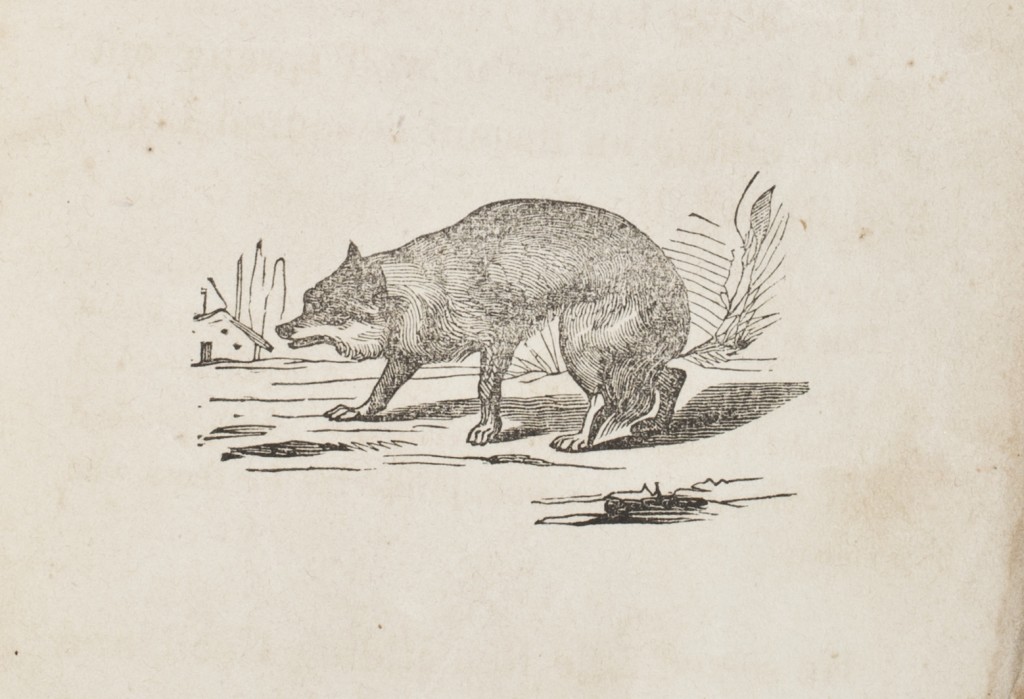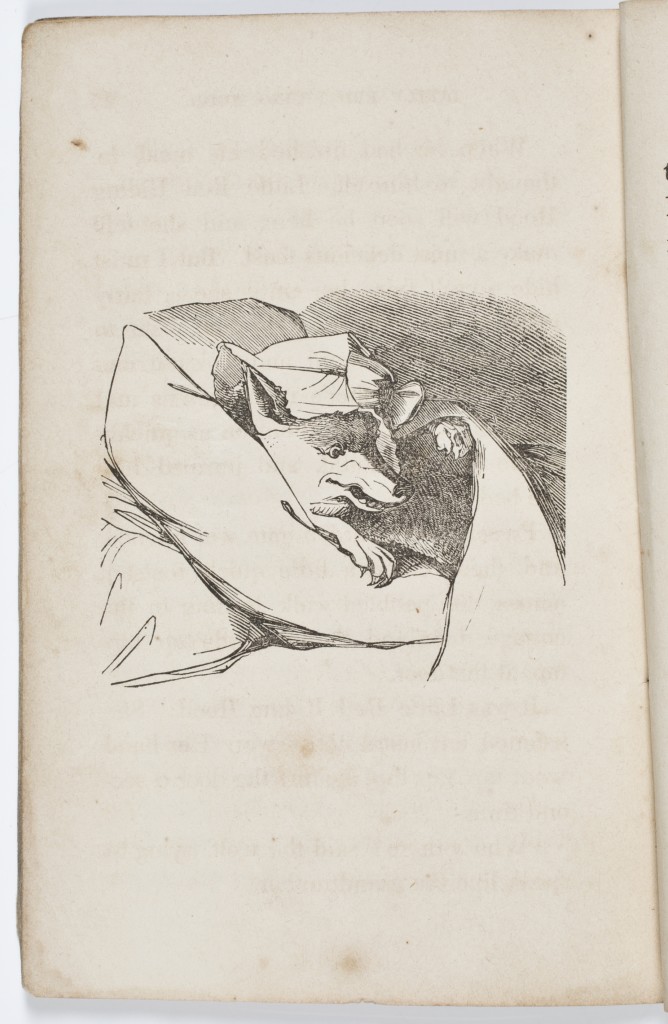Sloane Perron graduated from Anna Maria College in May and is currently finishing her position as a summer page for AAS. As an English major, the prospect of working hands-on with archives and first editions excited the bookworm inside her. She has greatly enjoyed her experiences at AAS and liked learning more about the collections as well as the behind the scenes aspects of a research library.
Readers will immediately recognize images of a young girl in a red cloak, a wolf dressed in a grandmother’s night dress, and a mysterious forest as being part of the story Little Red Riding Hood. Over the centuries, there have been countless adaptations and retellings of the well-known fairy tale. A quick search of the AAS catalog alone will reveal over a hundred items relating to Little Red Riding Hood. Each new version of the text brings to light different symbols and emphasizes different societal values. While paging in the Children’s Literature Collection at AAS, however, I came across three adaptations of the tale which exemplify just how individualistic and different the stories can be despite the fact that they are all based on the same fairy tale. These contrasts are particularly apparent in the endings of the stories.

One version of the tale, Little Red-Riding Hood published by John McLoughlin between 1854 and 1858, introduces the new characters of a wasp, a bird, an old woman, and a green huntsman. During her journey to “granddam’s” house, Red Riding Hood comes in contact with new characters and helps them. She saves the wasp, feeds the bird, cares for the old woman, and delivers a message to the huntsman. All of Red Riding Hood’s good deeds have delayed her visit to her grandmother’s where the wolf has already eaten her grandmother and now waits for the little girl. Just as the Wolf is about to eat Little Red Riding Hood, all of the creatures that she helped in the past repay her kindness by saving her life and killing the Wolf. It is later revealed that the old woman is actually a fairy and that the green huntsman is a mystical figure that only appears to those who are worthy. The story reveals that by respecting all of God’s creatures equally, Little Red Riding Hood was worthy of being saved herself.
The sweet and harmonic mood that I found in the first adaptation quickly turned macabre in the second story I read.

Published by J.L. Marks in London in the second half of the nineteenth century, The History of Little Red Riding Hood starts out as a sing-songy description of Red Riding Hood trekking through the woods on her way to grandma’s house. The trouble begins when she disobeys her mother’s orders not to loiter. Instead the little girl becomes distracted with playing in the woods and picking flowers when she runs into a Wolf. The naïve Red then makes matters worse by telling the creature that she is headed to her grandma’s house. The Wolf beats Red Riding Hood to the house where he eats grandma. Little Red Riding Hood pays the ultimate price for her disobedience when the Wolf gobbles her up as well. (The violence that was described in children’s literature during the 1800s was shocking!)
Last but certainly not least, is an adaptation of the fairy tale known as Little Red Riding Hood, published by Saxton & Kelt between 1845 and 1848. In this story, Red Riding Hood embodies perfection. She is beautiful, loved by all, industrious, creative, and compassionate. Her only flaw seems to be trusting the wolf and saving him. Predictably, the wolf races to the house and eats grandma and then proceeds to eat Little Red Riding Hood.

 However, my favorite moment occurs when the author hilariously inserts his own “voice” in order to create an alternate ending. Just when the end seems near for Little Red Riding Hood as she is consumed, the author adds, “This is the traditional ending of the Tale – but it is a grievous one, which most children dislike. – And as I heard a version related in which poetical justice is done to the wolf, I insert it for those who prefer it.” Instead of being the wolf’s dinner, this version of the story ends with Red Riding Hood being saved by a group of men working nearby while the wolf is killed.
However, my favorite moment occurs when the author hilariously inserts his own “voice” in order to create an alternate ending. Just when the end seems near for Little Red Riding Hood as she is consumed, the author adds, “This is the traditional ending of the Tale – but it is a grievous one, which most children dislike. – And as I heard a version related in which poetical justice is done to the wolf, I insert it for those who prefer it.” Instead of being the wolf’s dinner, this version of the story ends with Red Riding Hood being saved by a group of men working nearby while the wolf is killed.
In all three stories, Little Red Riding Hood is the epitome of stereotypical womanly beauty and virtue. Despite the vastly different ways in which the stories end, the Red Riding Hood tales all begin by describing this fairy-tale character in similar ways. She is used as a symbol to show what little girls should strive to be during this point in history. The stories demonstrate the limited behaviors that were socially acceptable for young girls. As a result, obedience seems central to the plot. The only time that the Red Riding Hood actually ends tragically is in “The History of Little Red Riding Hood” when the little girl blatantly disobeys her mother’s warning. As a consequence of not following the demands of her mother (and by extension the confines of socially acceptable behavior for women), Little Red Riding Hood is eaten by the Wolf.
The warning becomes horrifyingly clear for any child reading this version of the tale. Listen to your mother or bad things will happen! Can you imagine reading this right before bedtime?
Throughout the stories there is also a clear focus on Little Red Riding Hood’s physical features. In each of these three instances, she is referred to as beautiful, but her attractiveness is depicted as wholesome and natural. When I was a child reading fairy-tales, I remember the pictures of Red Riding Hood being sweet, rosy-cheeked girls or glamorous figures traipsing about in the woods. However, in these three particular pamphlets the illustrations were not what I was expecting. Instead of glamorous, the illustrations of Little Red Riding Hood were somewhat plain. Even the usual image of a vivid red cape was changed due to the fact that many of the pictures were black and white. In the version published by Saxton & Kelt, the girl does not even wear a red hood, but rather wears a bonnet in every scene. By making the physical descriptions and scenes realistic rather than larger than life, children reading the story would be able to relate to the character. As a result, they would have been better able to absorb the tales’ underlying lessons.
My interest in Gothic literature and fairy-tales led to my quest for Little Red Riding Hood stories in order to see how the main character evolves. After reading them, I realized that the red cloak may remain a constant image but the actual character of Little Red Riding Hood changes with each story because of societal influences. As a result, the girl behind the red cloak will always remain a mystery because there are so many interpretations of her. But I’ll have fun reading some of the other Little Red Riding Hood stories in the AAS collection as I try to compare endings and embedded lessons in the text. Maybe one day I’ll be able to understand the girl behind the red cloak!
